Yesterday morning, I was surprised to find Great Blue Herons already at the nests of the rookery at Farmington Bay WMA. There were more than twenty herons.
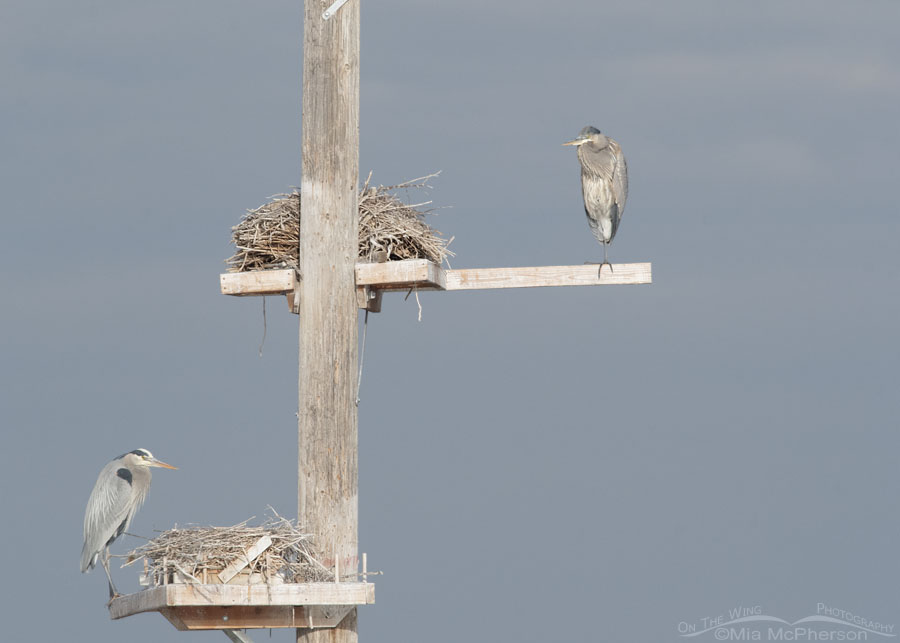 Two Great Blue Herons on the rookery at Farmington Bay WMA – Nikon D500, f11, 1/640, ISO 800, +1.0 EV, Nikkor 500mm VR with 1.4x TC, natural light
Two Great Blue Herons on the rookery at Farmington Bay WMA – Nikon D500, f11, 1/640, ISO 800, +1.0 EV, Nikkor 500mm VR with 1.4x TC, natural light
I didn’t stop to count the herons; I simply immersed myself in photographing them.
This photo shows an adult Great Blue Heron at the bottom left and the heron at the top right that was hatched last year, probably at this rookery. The streaky plumage of that bird is how I know it is not an adult.
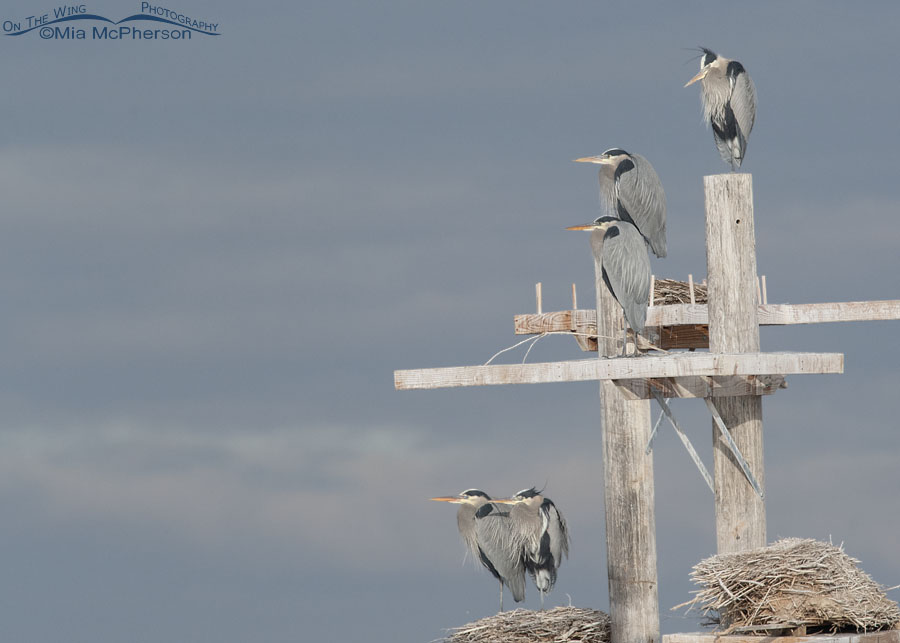 Great Blue Herons on the rookery at Farmington Bay WMA in January – Nikon D500, f11, 1/1250, ISO 800, +0.3 EV, Nikkor 500mm VR with 1.4x TC, natural light
Great Blue Herons on the rookery at Farmington Bay WMA in January – Nikon D500, f11, 1/1250, ISO 800, +0.3 EV, Nikkor 500mm VR with 1.4x TC, natural light
Clouds were moving in from the north by the time I got to the heron rookery. I didn’t mind the clouds; I think they created a more dramatic background than a plain blue sky would have.
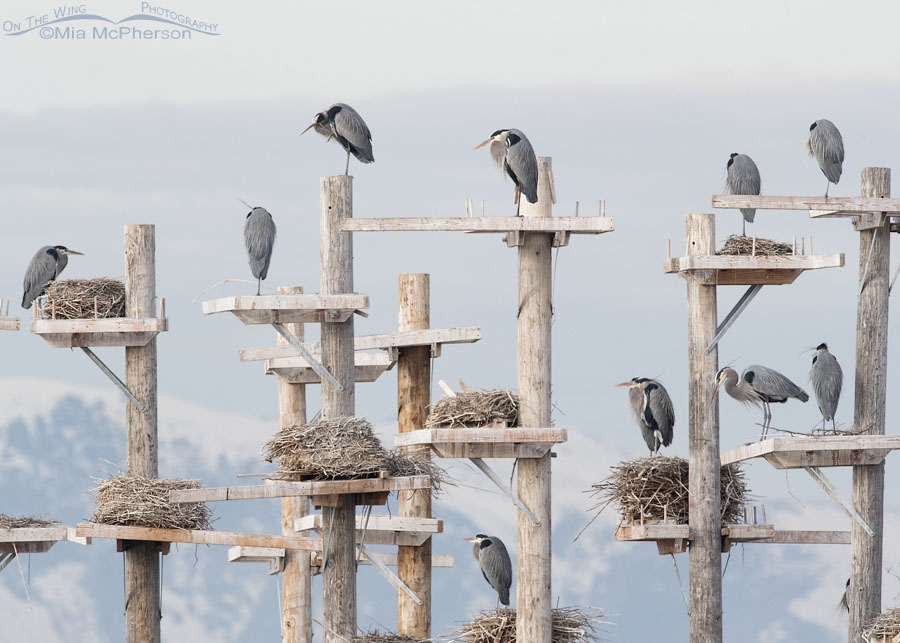 Great Blue Herons at the Farmington Bay WMA rookery – Nikon D500, f11, 1/500, ISO 800, +1.0 EV, Nikkor 500mm VR with 1.4x TC, natural light
Great Blue Herons at the Farmington Bay WMA rookery – Nikon D500, f11, 1/500, ISO 800, +1.0 EV, Nikkor 500mm VR with 1.4x TC, natural light
After moving a bit further away, I was able to photograph more herons at the rookery. This photo shows eleven of the herons, but one is nearly hidden. Can you find it?
The snow-covered mountains in the background of this image are the mountains on Antelope Island. By the time I took this photo, the clouds moving in from the north had muted the sunlight a bit.
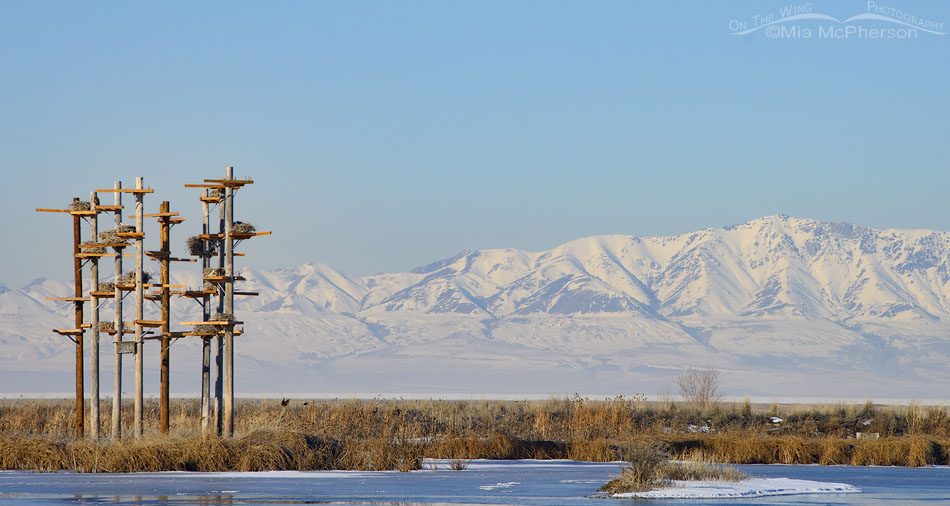 Heron rookery at Farmington Bay on a clear February morning – 2023 – Nikon D810, handheld, f11, 1/1000, ISO 400, +0.7 EV, Nikkor 70-300mm VR at 135mm, natural light
Heron rookery at Farmington Bay on a clear February morning – 2023 – Nikon D810, handheld, f11, 1/1000, ISO 400, +0.7 EV, Nikkor 70-300mm VR at 135mm, natural light
Typically, I don’t see the herons at the rookery until around the middle of February. This image was taken of the rookery on February 10th of last year, and there wasn’t a heron to be found on the nests. In 2022, the herons were at the rookery by February 18th.
We have been having a warmer winter than normal so far. I wonder if the Great Blue Herons are getting ready to breed already. Right now, I can only speculate that they might be getting ready to nest based on their behavior. Only time will tell, though.
These large, prehistoric-looking wading birds do nest early. January seems too early though.
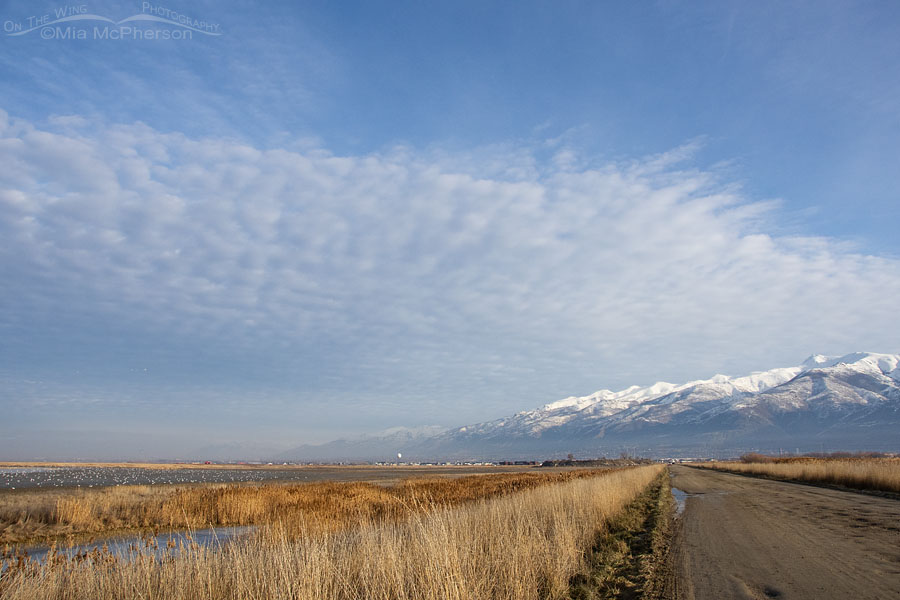 Clouds heading south over Farmington Bay WMA – Nikon D810, handheld, f9, 1/1600, ISO 400, +0.7 EV, Nikkor 18-200mm VR at 18mm, natural light
Clouds heading south over Farmington Bay WMA – Nikon D810, handheld, f9, 1/1600, ISO 400, +0.7 EV, Nikkor 18-200mm VR at 18mm, natural light
While I was at Farmington Bay WMA yesterday morning, I decided to take a few landscape images. This photo was taken from the road heading north to Goose Egg Island. The road was muddy, but I stepped out of my Jeep to get this wide-angle view.
Clouds were moving in from the north. The snow on the Wasatch Mountains isn’t as thick as it should be and doesn’t come as far down as it did last year.
This is what it usually looks like around early April. There wasn’t even a hint of snow on the ground at the WMA. There was some ice on the water, but not much.
It felt like spring.
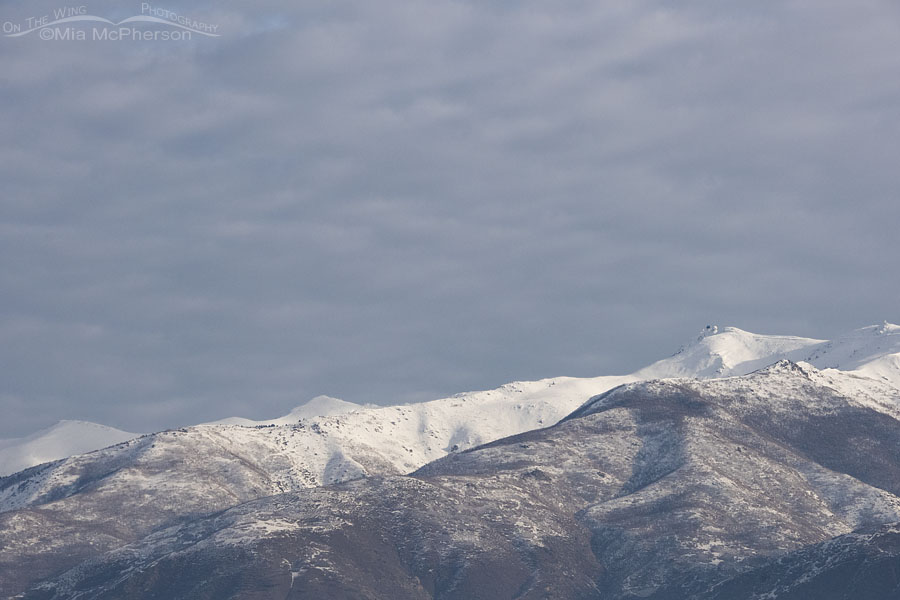 Clouds over the Wasatch Mountain peaks viewed from Farmington Bay WMA – Nikon D810, handheld, f11, 1/2000, ISO 800, Nikkor 18-200mm VR at 80mm, natural light
Clouds over the Wasatch Mountain peaks viewed from Farmington Bay WMA – Nikon D810, handheld, f11, 1/2000, ISO 800, Nikkor 18-200mm VR at 80mm, natural light
I zoomed in on the Wasatch Mountain peaks at one point while heading north to the heron rookery. The snow should be deeper, covering the lower elevations of the mountains. A bit of sunlight lit up the peaks, even though the clouds were thickening overhead.
Up in the mountains it looked like winter, down at the WMA? Not so much.
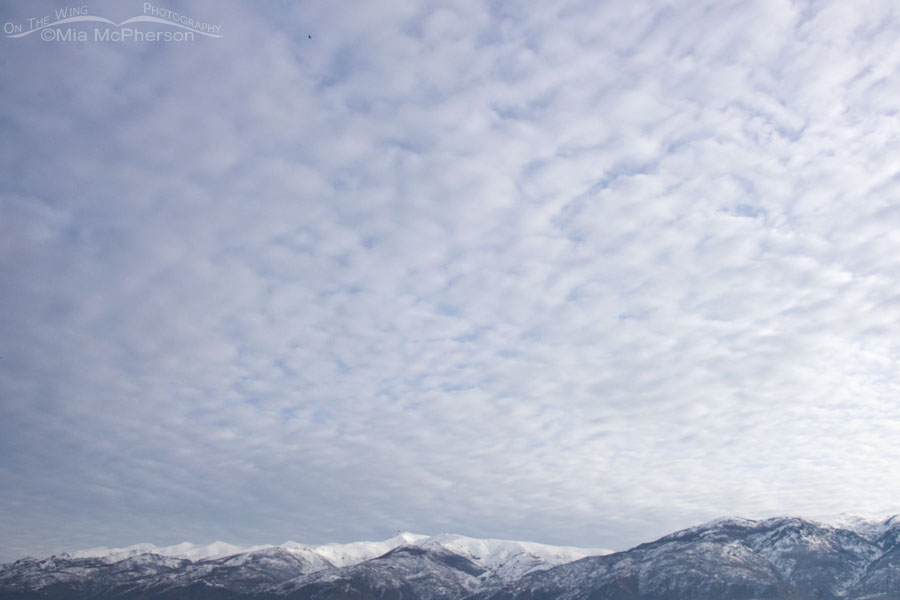 Clouds over the Wasatch Mountain Range viewed from Farmington Bay WMA – Nikon D810, handheld, f11, 1/800, ISO 400, +0.7 EV, Nikkor 18-200mm VR at 18mm, natural light
Clouds over the Wasatch Mountain Range viewed from Farmington Bay WMA – Nikon D810, handheld, f11, 1/800, ISO 400, +0.7 EV, Nikkor 18-200mm VR at 18mm, natural light
Before I arrived at the heron rookery, I stopped to take a few more photos of the clouds moving in over the Wasatch Mountain Range. I do love the views from Farmington Bay; that is, when I look up at the mountains.
Down at the WMA, it sickens me to see the West Davis Corridor, the new housing construction, and the scars on the land. There wasn’t a single place I went to at the WMA yesterday where I could escape the noise of traffic.
Progress isn’t always a good thing, and I believe Farmington Bay WMA has suffered greatly because of it. Just ask anyone who visited and loved it 10 or 15 years ago.
It is horribly sad. I don’t see it getting better at the WMA, only worse.
Mia
Click here to see more of my Great Blue Heron photos plus facts and information about this species. Click here to see more of my Farmington Bay WMA images plus facts and information about the WMA.
Like this:
Like Loading...
Related Posts
 Two Great Blue Herons on the rookery at Farmington Bay WMA – Nikon D500, f11, 1/640, ISO 800, +1.0 EV, Nikkor 500mm VR with 1.4x TC, natural light
Two Great Blue Herons on the rookery at Farmington Bay WMA – Nikon D500, f11, 1/640, ISO 800, +1.0 EV, Nikkor 500mm VR with 1.4x TC, natural light Great Blue Herons on the rookery at Farmington Bay WMA in January – Nikon D500, f11, 1/1250, ISO 800, +0.3 EV, Nikkor 500mm VR with 1.4x TC, natural light
Great Blue Herons on the rookery at Farmington Bay WMA in January – Nikon D500, f11, 1/1250, ISO 800, +0.3 EV, Nikkor 500mm VR with 1.4x TC, natural light Great Blue Herons at the Farmington Bay WMA rookery – Nikon D500, f11, 1/500, ISO 800, +1.0 EV, Nikkor 500mm VR with 1.4x TC, natural light
Great Blue Herons at the Farmington Bay WMA rookery – Nikon D500, f11, 1/500, ISO 800, +1.0 EV, Nikkor 500mm VR with 1.4x TC, natural light Heron rookery at Farmington Bay on a clear February morning – 2023 – Nikon D810, handheld, f11, 1/1000, ISO 400, +0.7 EV, Nikkor 70-300mm VR at 135mm, natural light
Heron rookery at Farmington Bay on a clear February morning – 2023 – Nikon D810, handheld, f11, 1/1000, ISO 400, +0.7 EV, Nikkor 70-300mm VR at 135mm, natural light Clouds heading south over Farmington Bay WMA – Nikon D810, handheld, f9, 1/1600, ISO 400, +0.7 EV, Nikkor 18-200mm VR at 18mm, natural light
Clouds heading south over Farmington Bay WMA – Nikon D810, handheld, f9, 1/1600, ISO 400, +0.7 EV, Nikkor 18-200mm VR at 18mm, natural light Clouds over the Wasatch Mountain peaks viewed from Farmington Bay WMA – Nikon D810, handheld, f11, 1/2000, ISO 800, Nikkor 18-200mm VR at 80mm, natural light
Clouds over the Wasatch Mountain peaks viewed from Farmington Bay WMA – Nikon D810, handheld, f11, 1/2000, ISO 800, Nikkor 18-200mm VR at 80mm, natural light Clouds over the Wasatch Mountain Range viewed from Farmington Bay WMA – Nikon D810, handheld, f11, 1/800, ISO 400, +0.7 EV, Nikkor 18-200mm VR at 18mm, natural light
Clouds over the Wasatch Mountain Range viewed from Farmington Bay WMA – Nikon D810, handheld, f11, 1/800, ISO 400, +0.7 EV, Nikkor 18-200mm VR at 18mm, natural light

Wow, a man made rookery. That is a good place to build a nest, unless there are strong winds.
What a terrific set of shots! The landscape pics are wonderful and the Heron rookery was amazing. I am really pleased to see the care and foresight taken to build that structure. Apparently the Herons like it too. Thanks Mia.
BTW – Is the mystery Heron hiding behind the post in the lower right corner? If so, I’m going to celebrate with a glass of champagne! [Well…maybe tonight.]
I am disappointed at Farmington Bay too. Was there yesterday but arrived too late for good lighting. The old easy access from I/15 is no longer there and I got lost. Few birds besides the herons.
Gorgeous photos! If the wooden platforms weren’t there where would they nest? I love GBHs. They’re fascinating!
Love this GBH rookery photo series!! Thank you. -Jeri S.
I have never seen a man made rookery but it seems to be just what the herons need. It is wonderful to see. Remember the one in Port Richey near the shopping center, it is all trees but this man made one fits just perfect as there are no trees there. Beautiful photos Mia!
Lovely photos. I have been hanging out there three evenings last week. Morning sun gets blocked by clouds in the morning stuck on the mountain tops. Sunset light usually is good, clear to the west. There were a couple herons each night, three herons at most on the nesting platforms. That is an incredible number you saw! Did you see the swans? They are getting closer. I think they will come in once hunting stops. I hope! With it being warmer they may move north sooner.
Lots and lots of herons. I do hope that they are not nesting too early and also that it isn’t a portent of the seasons to come. I mourn with you for the destruction of WMA.
I love these photos of the rookery. I live in Northern California and our herons nest high in trees, making it difficult to get good photos
Great shots Mia and yes, it does seem a little early although a friend says he saw a Canada Goose pair with eggs a couple days ago .. signs of a strange year happening??